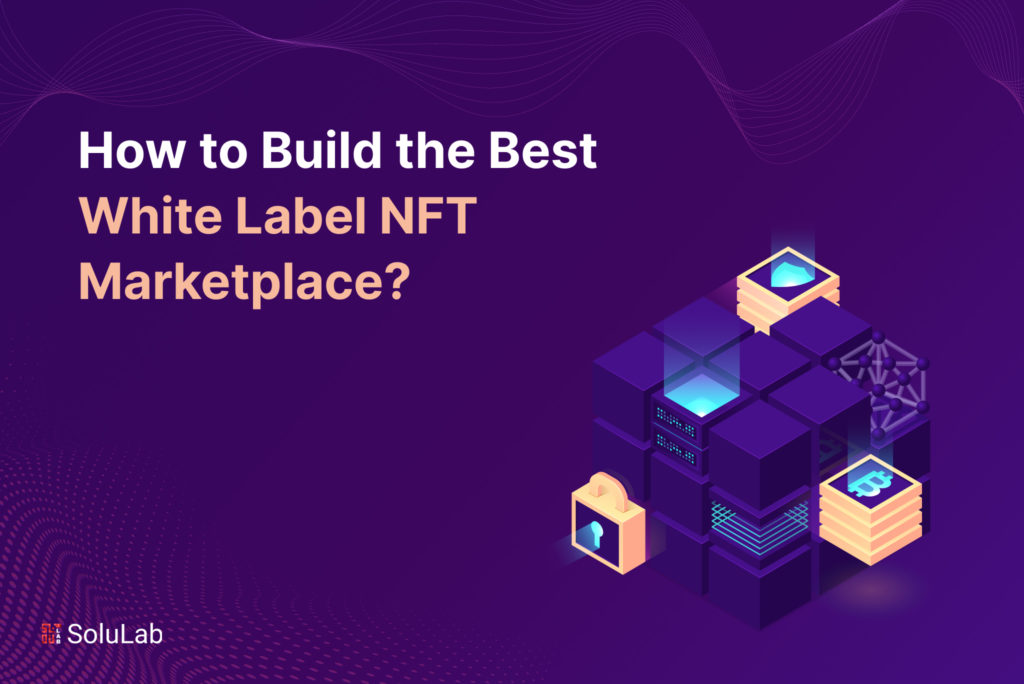
The world of digital assets is continually evolving, and at the forefront of this evolution lies the concept of white-label NFT marketplaces. These innovative platforms have garnered significant attention for their ability to revolutionize the way non-fungible tokens (NFTs) are bought, sold, and traded. In this exploration, we delve into the core components of white-label NFT marketplaces, highlighting their benefits and shedding light on key terms that shape this dynamic landscape.
At its essence, a white-label NFT marketplace is a pre-built, customizable platform that enables individuals or businesses to create their own NFT marketplace without developing the software from scratch. This approach offers a ready-to-use framework that can be tailored to suit specific branding, features, and requirements. White-label solutions provide the foundation for launching a personalized NFT marketplace, complete with functionalities like listing, bidding, and trading NFTs seamlessly.
The allure of white-label NFT marketplaces lies in their versatility and speed-to-market. By leveraging a white-label solution, entrepreneurs and enterprises can bypass the complexities of coding and programming, allowing them to focus on strategic aspects such as user experience, branding, and monetization strategies. This accelerated approach significantly reduces development time and costs while ensuring a professional, feature-rich marketplace that aligns with the organization’s vision.
Getting Any Results in Your Search for the Ideal White-Label NFT Platform?
In the ever-evolving realm of NFTs, the quest for the ideal white-label marketplace platform demands careful consideration of various factors. As you navigate the vast landscape of options, it’s crucial to assess and compare the offerings of these platforms to ensure a seamless NFT journey. Are you ready to dive into the process of selecting the perfect white-label NFT platform? Let’s explore three key areas that warrant your attention.
-
Evaluating Features of the Best White-Label Marketplace Platforms
When you’re seeking the optimal white-label NFT platform, features take center stage. The platform’s capabilities should align with your unique requirements, whether you’re an artist, creator, or enterprise.
Consider essential features such as user-friendly interfaces, secure payment gateways, robust search and filtering options, and integration with multiple blockchain networks. The ability to facilitate smooth interactions between buyers, sellers, and collectors is pivotal. A well-structured platform ensures that your NFT marketplace becomes a thriving hub for creative exchange.
-
Comparing Costs and Pricing Models
Financial considerations play a pivotal role in your decision-making process. As you delve into the world of white-label NFT platforms, comparing costs and pricing models is essential. Some platforms charge a percentage of each transaction, while others offer subscription-based pricing.
It’s imperative to comprehend the fee structures and their implications on your potential earnings. Striking a balance between the features you require and the pricing that fits your budget ensures a sustainable and lucrative NFT venture.
-
Analyzing Scalability, Customization Options, and Support Services
Scalability is the cornerstone of a successful NFT marketplace. Will the platform be able to handle increased traffic as your user base grows? Moreover, customization options are paramount. Your NFT marketplace should reflect your brand’s identity, allowing you to tailor the platform’s look and feel to resonate with your target audience.
While you’re at it, delve into the realm of support services. A responsive and knowledgeable support team ensures that you can swiftly navigate any technical hiccups or inquiries that arise on your NFT journey.
As you embark on the journey of selecting the ideal white-label NFT platform, remember that your choice will shape your NFT venture’s trajectory. By thoroughly evaluating features, comparing pricing models, and analyzing scalability and support, you’ll be equipped to make an informed decision that aligns with your vision. So, are you prepared to step into the realm of white-label NFT platforms and usher in a new era of creative exchange? Your NFT journey awaits.
How Do You Select the Right Technology Stack for Your White-Label NFT Marketplace?
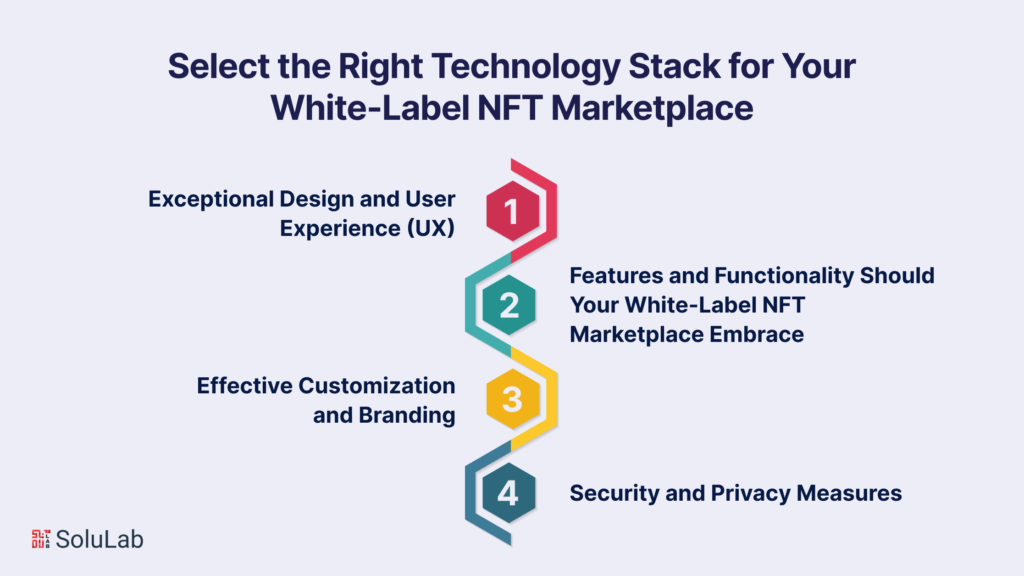
Selecting the technology stack for your white-label NFT marketplace is a crucial first step in building a successful platform. The right stack ensures efficiency, scalability, and compatibility with the latest trends. Consider the following factors when making your decision:
Exceptional Design and User Experience (UX)
-
Craft an Intuitive User Interface
Your NFT marketplace should have a user-friendly interface that makes navigation and usage seamless. Intuitive design enhances user engagement and encourages exploration.
-
Implement Responsive Design
Users access platforms from various devices. Create a responsive design that adapts to different screen sizes, ensuring a consistent experience for desktop and mobile users.
Features and Functionality Should Your White-Label NFT Marketplace Embrace
-
User Registration and Authentication
Implement secure and user-friendly registration and login processes. Consider two-factor authentication for added security.
-
NFT Listing and Management
Enable users to easily list, manage, and showcase their NFTs. Include features like high-quality images, descriptions, and customizable metadata.
Search and Discovery: Enhance user experience with robust search and discovery mechanisms, including filters, categories, and sorting options.
-
Secure Transactions and Payments
Implement a secure payment gateway that supports various cryptocurrencies. Ensure transaction history and details are transparent and easily accessible.
-
Wallet Integration
Seamless integration of users’ crypto wallets simplifies transactions and asset management. Compatibility with popular wallet providers is crucial.
-
Social Sharing and Engagement Features
Enable users to share NFTs on social media platforms, fostering community engagement and increasing visibility.
-
Analytics and Reporting
Provide users with insightful data on their NFT performance, sales, and user engagement. Analytics help users make informed decisions.
Read Our Blog Post: White Label NFT Marketplace – The Best Way of Launching NFT Platform
Effective Customization and Branding
-
Utilize White-Labeling Options
A white-label NFT marketplace offers customization possibilities. Allow users to personalize their storefronts, profiles, and listings, aligning with their brand identity.
-
Offer Custom Themes and Templates
Provide a range of themes and templates that users can choose from to create a unique and attractive storefront.
Security and Privacy Measures
-
Blockchain Integration for Transparency
Leverage blockchain’s transparency to ensure the provenance and authenticity of NFTs. Users can verify ownership and history through blockchain records.
-
Secure Smart Contracts
Implement secure and audited smart contracts to guarantee the execution of transactions and the automatic distribution of royalties.
-
Data Encryption and Privacy Settings
Prioritize user data protection by encrypting sensitive information and providing privacy settings for user profiles and transaction histories.
Building the best white-label NFT marketplace involves careful consideration of technology, design, features, and security. By following these steps, you’ll be well on your way to creating a platform that offers an exceptional user experience and supports the growth of the NFT ecosystem.
How to Choose a White-Label NFT Marketplace Development Company?
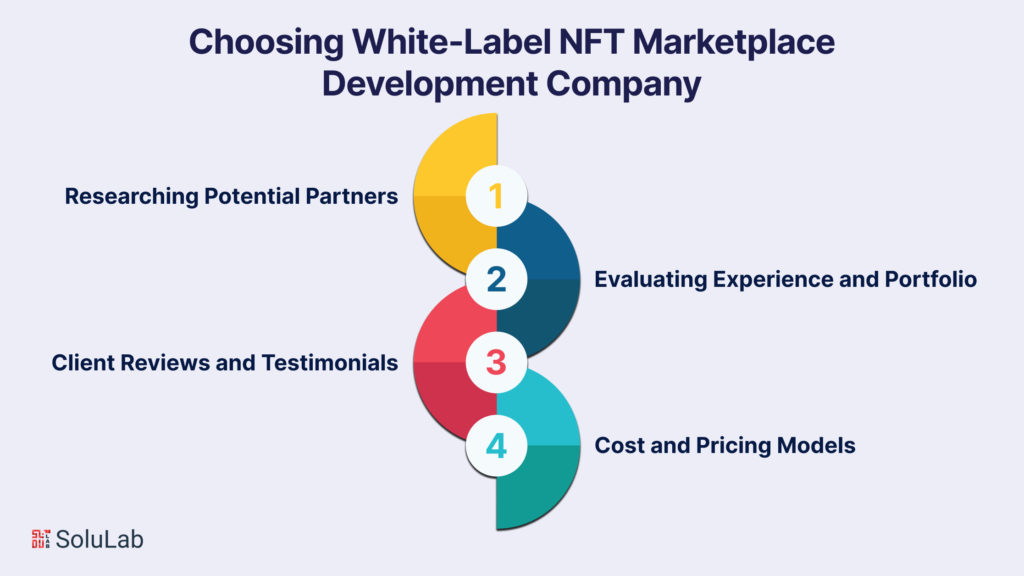
-
Researching Potential Partners
When selecting a white-label NFT marketplace development company, thorough research is essential. Start by identifying potential partners through online searches, industry forums, and recommendations. Look for companies that specialize in blockchain technology, NFT development, and white-label solutions. Compile a list of potential candidates to proceed with.
Read Blog: What are the Key Features of the White-Label NFT Marketplace?
-
Evaluating Experience and Portfolio
The experience of the development company is a critical factor. Examine their portfolio to gauge their expertise in creating NFT marketplaces. Review their previous projects to see if they align with your vision and requirements. Look for features, designs, and functionalities they’ve implemented in their previous works to ensure they match your expectations.
-
Client Reviews and Testimonials
Client reviews and testimonials provide insights into the development company’s performance from the perspective of those who have worked with them before. Search for reviews on platforms like Clutch, Upwork, or Google, as well as on social media and industry-related forums. Positive reviews and satisfied clients are indicators of a reliable and capable partner.
-
Cost and Pricing Models
While cost shouldn’t be the sole determinant, it’s a crucial aspect to consider. Different development companies might offer varying pricing models, such as fixed pricing, hourly rates, or project-based quotes. Compare these pricing models against your budget and project requirements. Remember that a balance between cost and quality is vital; a lower cost may not always translate to the best results.
What are the Future Trends in White-Label NFT Marketplaces?
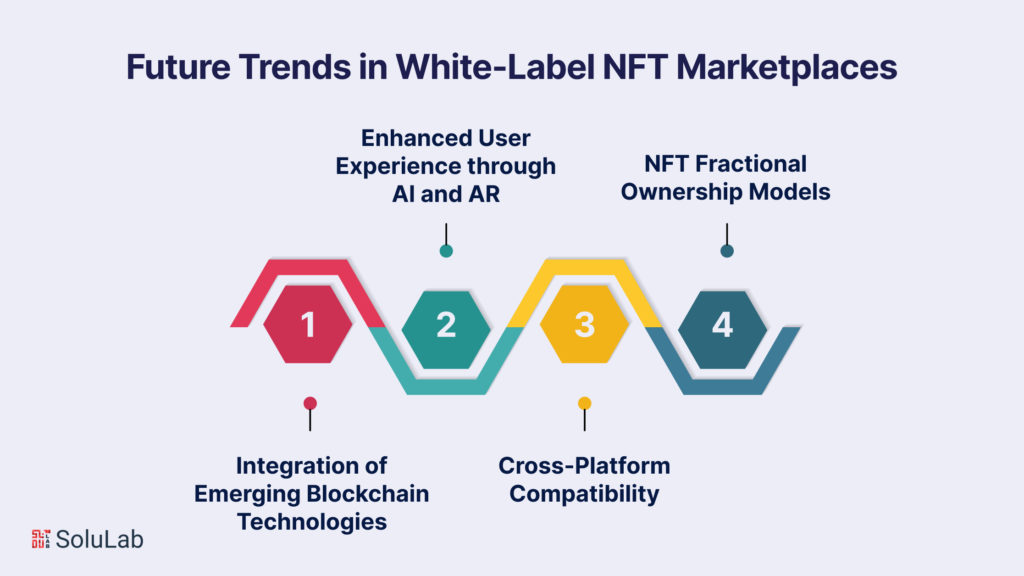
-
Integration of Emerging Blockchain Technologies
As white-label NFT marketplaces guide to evolve, the integration of emerging blockchain technologies will play a significant role. Blockchain networks beyond Ethereum, such as Polkadot and Solana, are gaining traction for their scalability and interoperability features.
These networks offer improved transaction speeds and reduced fees, addressing some of the limitations of the current NFT ecosystem. This integration opens the door for artists, collectors, and investors to explore new possibilities while maintaining the security and authenticity that blockchain technology provides.
-
Enhanced User Experience through AI and AR
The future of white-label NFT marketplaces will likely see the integration of Artificial Intelligence (AI) and Augmented Reality (AR) technologies to enhance user experiences. AI can personalize recommendations based on user preferences, increasing engagement and discoverability.
AR, on the other hand, can allow users to visualize NFTs in real-world settings, enabling a more immersive interaction with digital assets. This fusion of AI and AR will transform the way users interact with NFTs, making the experience more interactive and dynamic.
-
Cross-Platform Compatibility
With the increasing adoption of NFTs, cross-platform compatibility will become a prominent trend. White-label NFT marketplaces will likely focus on creating seamless experiences across different devices and platforms, including desktop, mobile, and even gaming consoles.
This ensures that users can access and manage their NFTs from various sources, promoting broader engagement and utility of these digital assets.
Read Our Blog: White Label NFT Marketplace: Find Out Its Pros And Cons
-
NFT Fractional Ownership Models
Fractional ownership of NFTs is poised to revolutionize the NFT marketplace landscape. This trend involves breaking down ownership of a high-value NFT into smaller, tradable fractions.
Investors can own a portion of valuable NFTs, making the market more accessible to a wider range of participants. White-label NFT marketplaces are expected to incorporate secure fractional ownership mechanisms, enabling users to invest in premium NFTs without committing to the entire purchase.
How to develop the best White-Label NFT Marketplace?
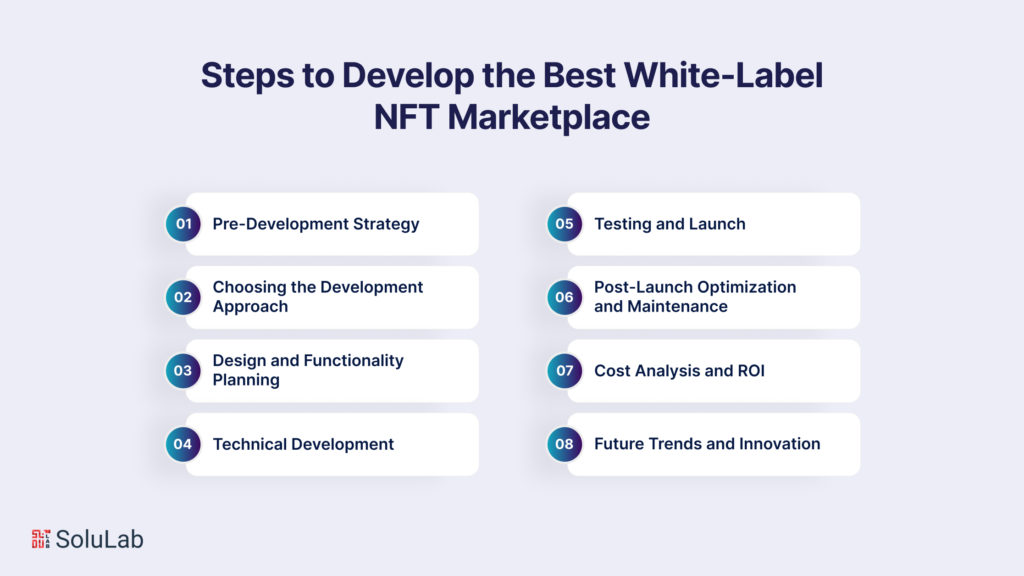
Developing the best white-label NFT marketplace involves a strategic approach encompassing several key steps:
-
Pre-Development Strategy: Market Research and USP
Before initiating development, thorough market research is essential to identify trends and gaps in the NFT marketplace landscape. Defining a unique selling proposition (USP) will set your platform apart. Understanding the target audience, popular niches, and potential competitors helps tailor the marketplace’s features and design.
-
Choosing the Development Approach: Custom vs. Pre-Built
Decide whether to build from scratch or leverage pre-built solutions. Custom development offers more flexibility and tailored features, while pre-built platforms save time and costs. Partnering with a reputable white-label NFT marketplace development company is crucial for technical expertise and guidance.
Read Also: How will White-Label NFT Marketplace Development Benefit your Business?
-
Design and Functionality Planning: User-Centric Approach
User experience (UX) and user interface (UI) design play a pivotal role. Intuitive navigation, appealing aesthetics, and seamless interactions are vital. Plan features like user registration, NFT listing, auctions, wallet integration, search mechanisms, and analytics dashboards to ensure a comprehensive marketplace.
-
Technical Development: Front-End and Back-End
The front-end development involves implementing UI/UX designs and ensuring responsive interfaces for various devices. On the back end, establish a robust database architecture and integrate NFT smart contracts for secure ownership verification. Implement user authentication, real-time auction mechanics, payment gateways, and wallet management.
-
Testing and Launch: Quality Assurance and Promotion
Rigorous testing of functionality, security, and performance is crucial. Conduct soft launches and beta testing to gather user feedback and make necessary refinements. Develop a marketing strategy involving content marketing, SEO, social media campaigns, and partnerships with artists to create buzz around the launch.
-
Post-Launch Optimization and Maintenance
Continuously gather user feedback and iterate on the platform. Monitor and maintain the marketplace by fixing bugs, implementing security updates, and enhancing scalability. Consider potential revenue streams such as transaction fees, premium features, or subscription models to sustain the platform.
-
Cost Analysis and ROI
Conduct a comprehensive cost analysis, factoring in development, maintenance, and operational expenses. Assess potential revenue streams to calculate the return on investment (ROI) over time, ensuring the marketplace’s sustainability.
-
Future Trends and Innovation
Stay attuned to emerging trends in NFT marketplaces, such as virtual reality (VR) and augmented reality (AR) integrations, fractional ownership, and enhanced discoverability. Be prepared to adapt and innovate to remain competitive in the evolving landscape.
Conclusion
In the realm of NFT marketplaces, the quest for the ideal solution culminates in the creation of the best white-label NFT marketplace. Assembling this pinnacle of innovation requires a thorough understanding of the market’s nuances and an adept approach to development. A paramount consideration lies in the choice of a reliable partner, such as SoluLab, a pioneering white-label NFT marketplace development company.
The journey commences with comprehending the significance of a white-label NFT platform. This endeavor isn’t solely about technology; it’s about crafting an experience that resonates with users and creators alike. While cost remains a factor, it pales in comparison to the value derived from a platform that seamlessly blends customization, security, and user-friendliness.
Building the best white-label NFT marketplace necessitates transcending the ordinary. It demands harnessing cutting-edge technology while staying attuned to the pulse of the NFT ecosystem. In this pursuit, a trusted partner like SoluLab emerges as a guiding light. Their expertise in white-label NFT marketplace development ensures that every facet – from smart contracts to user interfaces – is meticulously curated to foster success. Contact SoluLab today to embark on your NFT journey.
FAQs
1. What is a white-label NFT marketplace?
A white-label NFT marketplace is a platform that allows businesses to create their own branded NFT marketplace without having to build it from scratch. It provides pre-built solutions that can be customized to match the brand’s identity.
2. Why should I consider a white-label NFT marketplace?
A white-label NFT marketplace offers a cost-effective and time-efficient solution for launching your own NFT platform. It eliminates the need for extensive development and allows you to focus on branding and user experience.
3. What factors contribute to building the best white-label NFT marketplace?
The best white-label NFT marketplace is built on a reliable platform, offers robust customization options, ensures security for NFT transactions, provides user-friendly interfaces, and offers scalability as your platform grows.
4. How much does it cost to create a white-label NFT marketplace?
The cost of a white-label NFT marketplace can vary depending on the features, customization, and complexity you require. It’s recommended to consult with a white-label NFT development company for a tailored quote.
5. What is the role of a white-label NFT development company in this process?
A white-label NFT development company that specializes in creating customizable NFT marketplace solutions. They handle the technical aspects, security, and customization, allowing you to focus on branding and marketing.
6. Can I customize the look and feel of my white-label NFT marketplace?
Yes, most white-label NFT marketplace solutions offer extensive customization options, including branding, design, and user interface adjustments, ensuring your marketplace aligns with your brand identity.






